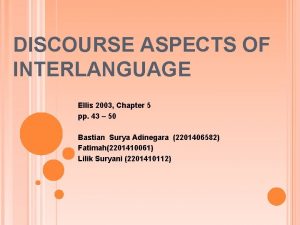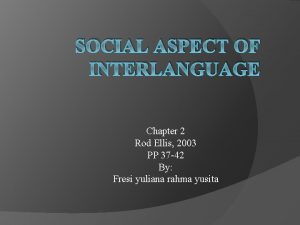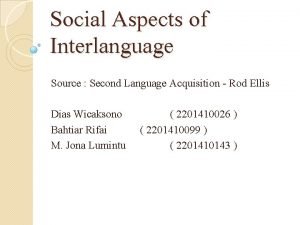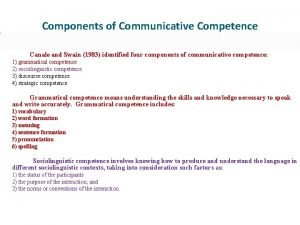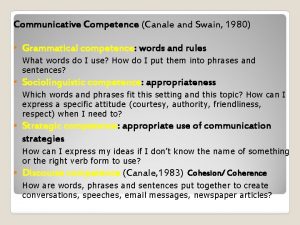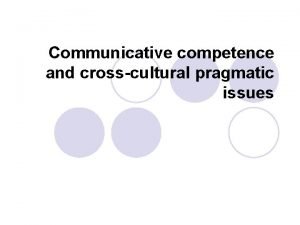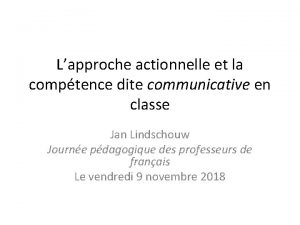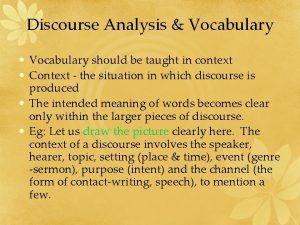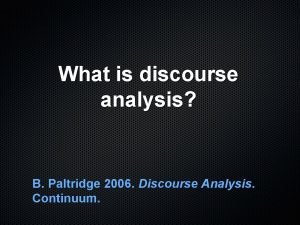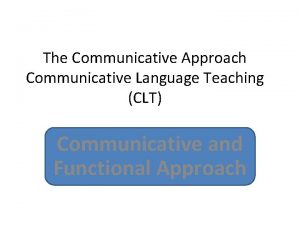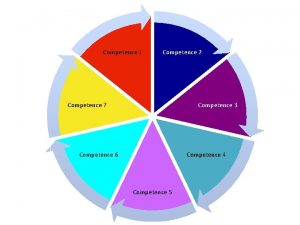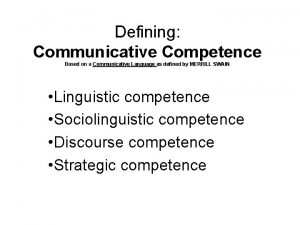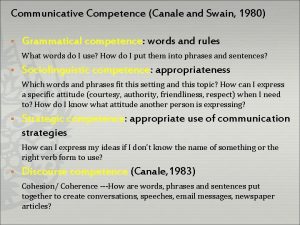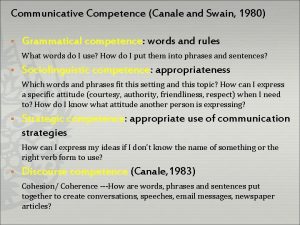Chapter 5 Discourse aspects of interlanguage Communicative Competence


















- Slides: 18

Chapter 5 Discourse aspects of interlanguage

Communicative Competence (Canale and Swain, 1980) § Grammatical competence: competence words and rules What words do I use? How do I put them into phrases and sentences? § Sociolinguistic competence: competence appropriateness Which words and phrases fit this setting and this topic? How can I express a specific attitude (courtesy, authority, friendliness, respect) when I need to? How do I know what attitude another person is expressing? § Strategic competence: competence appropriate use of communication strategies How can I express my ideas if I don’t know the name of something or the right verb form to use? § Discourse competence (Canale, 1983) Cohesion/ Coherence ---How are words, phrases and sentences put together to create conversations, speeches, email messages,

Q: IL discourse errors: universal or language specific? (p. 44)

Q: Review(p. 44) • Behaviorist view of L 2 acquisition • Mentalist view of L 2 acquisition • Interactionist view of L 2 acquisition

Q: What is foreigner talk? (p. 45) Examples? (p. 46)


Simplification in Grammatical FT

Q: Long’s interaction hypothesis (p. 47)

Interactional modification: Negotiation of meaning (p. 47) NNS: The windows are crozed NS: The windows have what? ---negative evidence NNS: Closed? NS: Crossed? I’m not sure what you are saying here. NNS: Windows are closed. NS: Oh, the windows are closed, OK, sorry

The structure of meaning of negotiation S 1: What is your father’s job? S 2: My father now is retire. ---Trigger S 1: Retire? ---Indicator of misunderstanding S 2: Yes ---Response S 1: Oh, yes. ---Reaction to response

Modified output may arise in negotiation

Negotiation strategy Description Example Type

Example 1 (Mackey and Philp, 1998: 344) NNS: What they doing? NS: What are they doing? (---recast) NNS: Yeah NS: They’re signing a contract

Example 2 (Doughty and Varela, 1998: 124) Jose: I think that the worm will go under soil. Teacher: I think that the worm will go under soil? (---repetition) Jose: (no response) Teacher: I thought that the worm would go under the soil. (---recast) Jose: I thought that the worm would go under the soil.

Q: Scaffolding (p. 48)

Effective types of scaffolding (Bradley, 2004, p. 1). 1. Simplifying language 2. Ask students to complete sentences or fill in the blank rather than having them try to come up with the entire sentence 3. Use visuals 4. Use gestures

Zone of Proximal Development (ZPD) (p. 48) An area of learning that occurs when a person is assisted by a teacher or peer with a skill set higher than that of the subject. The teacher then helps the student attain the skill the student is trying to master, in hopes that the teacher will no longer be needed for that task. (Vygotsky, 1978).

Q: Why is ‘comprehensible output’ important in SLA? (p. 49)
 Discourse aspects of interlanguage
Discourse aspects of interlanguage Stylistic continuum
Stylistic continuum Psycholinguistics aspects of interlanguage
Psycholinguistics aspects of interlanguage Interlanguage and stylistic continuum
Interlanguage and stylistic continuum Psycholinguistic aspects of interlanguage
Psycholinguistic aspects of interlanguage Psycholinguistic aspects of interlanguage
Psycholinguistic aspects of interlanguage Undelies
Undelies Psycholinguistic aspects of interlanguage
Psycholinguistic aspects of interlanguage Canale and swain's model of communicative competence
Canale and swain's model of communicative competence Communicative competence canale and swain
Communicative competence canale and swain Communicative competence
Communicative competence La compétence communicative
La compétence communicative La compétence communicative
La compétence communicative Vocabulary and organizing of text
Vocabulary and organizing of text Discourse organizing words
Discourse organizing words Discourse competence adalah
Discourse competence adalah Discourse competence
Discourse competence Discourse analysis in linguistics
Discourse analysis in linguistics Chapter 9 cultural competence
Chapter 9 cultural competence
